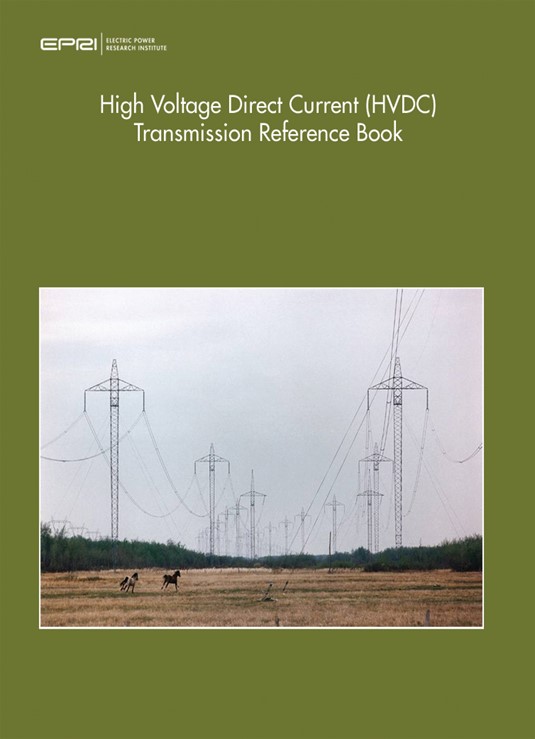Reference Information
Key information from reference documents and guides (e.g.) or succinct descriptions of concepts (e.g. what is risk and how do I visualize it)
This the multi-page printable view of this section. Click here to print.
Key information from reference documents and guides (e.g.) or succinct descriptions of concepts (e.g. what is risk and how do I visualize it)
Over the last two decades, EPRI developed a comprehensive reference book covering many aspects of HVDC technology and it is being updated annually with the latest information. The 2023 edition of the EPRI HVDC Transmission Reference Book consists of the following 30 chapters:
With the introduction of renewable power generation, the power flows on the HV systems are changing. As a result, some lines are overloaded whereas the loading on other lines is well below their thermal capability. Building new lines is becoming more and more challenging due to environmental permitting and capital costs. The transmission operators are looking for the application of FACTS (Flexible AC Transmission Systems) controllers to mitigate power flow and other issues like voltage regulation. FACTS controllers have been used for steady state, transient and dynamic stability of power systems and for damping system oscillations all around the world for more than 30 years. Series reactance of long transmission lines limits their power transmission capacity. System operators often need to keep the power flow in long transmission line well below their thermal limits to maintain sufficient transient stability margin. This leads to underutilization of the transmission assets.
Series FACTS controllers are being used to increase power flows in the existing AC systems. Series capacitors, Thyristor Controlled Series Capacitors (TCSCs), and Static Synchronous Series Compensators (SSSCs) could be used as series controllers to maximize the power flow on the existing AC transmission corridors. EPRI studied these options and published the EPRI Technical Update 3002021404 – Technical and Operational Comparison of Thyristor Controlled Series Capacitor (TCSC) and Static Synchronous Series Compensator (SSSC), July 2021.
Shunt compensation is used to improve the voltage profile in the transmission systems by providing necessary reactive power. Though shunt capacitors and shunt reactors can be used for static reactive power compensation, dynamic reactive power compensation is needed to maintain the voltage profiles and optimize the power flow on the transmission systems during different operating conditions including equipment outages. Dynamic reactive power compensation can be provided using power electronics-based compensators such as Static Var Compensators (SVC) and Static Synchronous Compensator (STATCOM) and rotating machine based such as Synchronous Condenser. EPRI studied the comparative advantages and limitations of these technologies and published the EPRI Technical Update 3002024629 – Technical and Operational Comparison of SVC, STATCOM, and Synchronous Condensers, April 2022.
The most sophisticated FACTS controllers include Unified Power Flow Controller (UPFC) and Interline Power Flow Controller (IPFC). UPFC consists of a STATCOM and a SSSC and thus provides both series and shunt compensation to the AC system. IPFC consists of two or more SSSCs, one in each line and thus transfer active power from one line to the other.
EPRI report- 3002027143 published in 2023 describes the operation of STATCOM, SSSC, UPFC and IPFC and focuses on technical and operational comparison of the UPFC and IPFC technologies.
A FACTS Application Guide is being prepared in 2024 comparing all the FACTS controllers along with the synchronous condenser.

EPRI High Voltage Direct Current Transmission Reference Book (Olive Book): 2023 Edition:
The EPRI High-Voltage Direct Current (HVDC) Transmission Reference Book is a state-of-the-art guidebook that provides transmission companies with a comprehensive, single source of technical information and guidance for designing, building, operating, and extending the life of HVDC transmission systems. The book joins the landmark series of EPRI power delivery reference books. These comprehensive guidebooks—each printed with a distinctive colored cover—document and distill the knowledge and experience of the world’s leading power delivery experts. In this tradition, the EPRI HVDC Transmission Reference Book will be printed with a dark green cover and be referred to as the “Olive Book.”
The Olive Book consists of 30 chapters, covering all aspects of the theory and practice of HVDC transmission, including planning, system studies, AC-DC interactions, design of converter equipment, overhead lines and cables, project implementation, and operation and maintenance. This edition of the Olive Book had updates on Chapter 13, “DC Transmission with Voltage Source Converters” with the latest information as well as edits for all chapters for hardcopy printing.